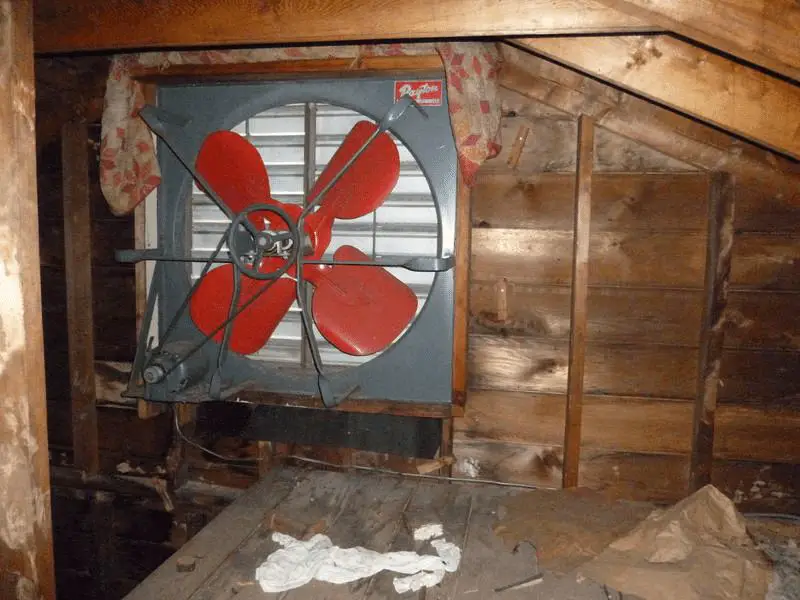Attic fans, also known as whole house fans, were once a popular way to cool homes during warm weather. However, attic fan usage has declined over the past few decades. There are several reasons why attic fans are not as widely used anymore.
Page Contents
Introduction to Attic Fans
An attic fan is a large fan mounted in the attic or roof that pulls air in from open windows and vents it out through attic vents. This creates a flow of air through the house, bringing in cooler outdoor air and flushing out hot indoor air. Attic fans were most commonly used in hot climates before the advent of air conditioning.
Attic fans offer some potential benefits such as:
- Lower energy costs – Attic fans use less electricity than air conditioners.
- Whole house cooling – Draws air in from the whole house rather than cooling just one room like a window AC unit.
- Fresh outdoor air – Pulls in fresh air from outside rather than recirculating indoor air.
Despite these advantages, attic fan use has declined over time. Here are some of the reasons why:
Availability of Air Conditioning
The primary reason attic fans are not used as much is the widespread availability of air conditioning. Window air conditioner units became affordable for the average home in the 1950s. Central air conditioning became common in homes by the 1970s and 1980s.
Air conditioning is more effective and convenient than attic fans. Air conditioners actively cool and dehumidify the air, while attic fans just exhaust heat. Central A/C systems cool the whole house without having to open windows in each room. Air conditioning is available 24/7 at the flip of a switch, unlike attic fans that only work when conditions allow their use.
While attic fans can reduce some air conditioning costs, most homeowners today opt for the comfort and convenience of dedicated air conditioning over using attic fans. Air conditioning has become expected and standard in most homes.
Limited Conditions for Use
Attic fans are only effective under certain conditions:
- At night or early morning when outdoor air is cooler than indoor temperatures.
- Requires open windows to draw in outdoor air.
- Not effective at removing humidity on muggy days.
- Less effective on hot days over 90°F.
This limited scope of use means attic fans cannot replace air conditioning which works all day. Modern lifestyles with varied schedules and daytime cooling needs also decrease the usefulness of attic fans for many homes.
Noise and Privacy Concerns
Attic fans require opening windows which can raise noise and privacy issues:
- The loud noise of the fan itself can make it hard to sleep.
- With windows open, outdoor and neighbor noises come in.
- Open windows reduce privacy from neighbors.
- Exhaust fans suck out conditioned air, wasting energy.
These downsides make attic fans unappealing for many homes, especially in urban areas. Air conditioning avoids these issues by recirculating indoor air with closed windows.
Advances in Building Standards
Tighter building standards and improved insulation have also decreased the need for attic fans:
- Better insulation keeps heat out of the attic.
- Tight construction reduces natural air leakage.
- Exhaust fans remove heat and humidity at the source.
- Passive attic ventilation replaces need for powered fans.
Well-insulated and sealed attics have less heat buildup for an attic fan to remove. Many attics can stay reasonably cool with proper insulation, ventilation, and roof color alone.
Decline of Whole House Fans
Here is a table summarizing the decline in shipments of whole house fans, including attic fans, over time:
| Year | Shipments |
|---|---|
| 1995 | 480,000 |
| 2000 | 250,000 |
| 2005 | 180,000 |
| 2010 | 130,000 |
| 2015 | 110,000 |
Shipments of these fans declined by over 75% from 1995 to 2015. This shows the rapid decrease in attic fan installations over recent decades. Higher energy standards, more homes with A/C, and lifestyle changes have made attic fans obsolete in many areas.
Higher Energy Standards
Stricter residential energy standards have reduced the benefits of attic fans in new construction:
- Required insulation levels limit attic heat buildup.
- Tight construction reduces natural leakage that fans remove.
- Exhaust fan requirements handle moisture at the source.
- Passive attic ventilation and cooling techniques are mandated.
With these heat and moisture control measures in place, there is less need for active cooling from attic fans. Cooling load calculations for HVAC sizing also assume proper attic heat control without fans.
Maintenance Issues
Operational and maintenance problems are another barrier to attic fan usage:
- Fan motors can fail over time.
- Fans collect dust and debris reducing airflow.
- Shutters can become stuck or damaged.
- Requires annual inspection and cleaning.
- Accessing fans in attic is difficult in many homes.
Without proper maintenance, attic fans become less effective and can stop working entirely. The hassle and costs of maintenance make attic fans unappealing to many homeowners today.
Conclusion
In summary, attic fans have declined in popularity due to:
- Widespread availability of air conditioning.
- Limited conditions when attic fans are effective.
- Noise, privacy, and comfort issues with open windows.
- Improved building techniques reducing cooling needs.
- Steep drop off in new attic fan installations.
- Stricter residential energy standards.
- Ongoing maintenance requirements.
Modern homes have access to convenient, effective air conditioning. Tighter building envelopes and improved insulation also lessen the need for attic fans. While attic fans still have niche uses, their heyday has passed in most areas. The average homeowner today sees air conditioning as a more practical solution for whole house cooling needs.
